Trends in Use of Crop Cultivars from Organic and Conventional Seed Multiplication: Moving Toward 100% Organic Seed Use in German Organic Agriculture
Abstract:
In compliance with European Regulation (EC) 2018/848, organic farming practices necessitate the use of organically produced seeds when available. When suitable organic seeds cannot be sourced, farmers may seek an exemption permitting the use of non-organic seeds. This study examines data from the German national organic seed database to assess trends in the use of crop varieties originating from both organic and conventional seed production. Findings reveal that the diversity of cultivars produced organically is expanding across 15 of the 17 analyzed crops. Correlation analysis suggests that as the availability of organic cereal seed cultivars rises, recorded in the national database, the demand for derogations to use conventional cereal seed cultivars decreases, and vice versa. This positive development in the organic seed sector implies that farmers are adapting their practices in response to the expanding supply of organically multiplied cultivars available through the national database. Nevertheless, challenges such as crop diseases and production limitations in organic cereal seed multiplication can lead to supply deficits, which subsequently result in increased derogation requests for non-organic seeds in the following year. The findings underscore the importance of ensuring robust multiplication of organic cereal seeds to increase the supply, leading to higher adoption of organic seeds and a reduction in derogation requests for non-organic seeds. This study contributes to understanding the impact of supply trends on farmer behavior and highlights the need for further strengthening organic seed multiplication to facilitate full compliance with European organic farming regulations.1. Introduction
The Farm to Fork Strategy of the European Green Deal aims to increase the designated area for organic farming across the entire European Union (EU) by up to 25% by 2030 (European Commission, 2020). Reaching this aim involves tackling the challenge of ensuring an adequate supply of organic seeds (Solfanelli et al., 2021). The use of organic seeds and vegetative propagating materials, also defined as plant reproductive materials, is mandatory in organic farming. The EC 2018/848 (European Union, 2018) and its implementation regulations 2020/464 (European Union, 2020) and 2022/474 (European Union, 2022) define the conditions that allow for organic farmers to apply for a derogation regarding the use of non-organic seeds without chemical postharvest treatments. Döring et al. (2012) proposed that, due to the low investment in the past or for other market-related reasons, organic seeds were often not available in sufficient quantity. Thus, European member states report a high number of derogations for the use of non-organic seeds each year (Solfanelli et al., 2021). Solfanelli et al. (2022a) provided the first European-wide estimation of organic seed supply and demand. Their research showed that the share of certified organic seeds, organic farm-saved seeds and non-organic seeds which were purchased differed between crops and regions within Europe. On average, the share of non-organic seeds, granted through derogations, varied between 48.5% in eastern European regions and 18.6% in central European regions. Solfanelli et al. (2022a) also found differences between crop types. Fruit production farms used the most non-organic seeds (41.9%), followed by forages (35.6%), arable farms (29.8%), and vegetable farms (24.6%). The reported high proportion of non-organic seeds showed that the supply of suitable varieties of organic seeds in Europe was still lacking.
The new EC 2018/848 foresees a phasing out of derogations on the use of non-organic seeds by the end of 2036 (European Union, 2018). Padel et al. (2021) stated that the full enforcement of the regulation to use only organic seeds might have unforeseen consequences, such as a reduction in agrobiodiversity in organic farming, rather than supporting an increase in supply. Padel et al. (2021) further concluded that, in Europe, the market alone was unlikely to deliver a hundred percent organic seeds, as the market was characterised by its small size, a wide diversity of crops being grown, unresolved technical problems for certain crop species and a limited capacity of breeding varieties adapted to organic farming conditions.
In Germany, organic farming has a long history of development. Germany was the first country to use the EU’s funds specifically to promote organic farming, which began as early as the late 1980s (Willer & Schmid, 2016). From 2004 to 2020, the area of organic farmland increased from 767.9 thousand hectares to 1.7 million hectares. This corresponded to a land share of 10.2% in 2020 (BOLW, 2022; FiBL, 2023). Although this is far from the 25% European Green Deal’s goal (European Commission, 2020), the annual increase in organic land in absolute numbers is among the highest in the EU. Germany is a top-performing country in terms of land used for cereal cultivation and dry pulses, together with France and Italy (Willer et al., 2021). Similar to other EU member states, the German Ministry of Agriculture has representation in the Committee of Organic Production. The Ministry of Agriculture has a mandate to deliver an opinion and vote on a draft of the Council Regulation which involves the implementation of organic production and the labelling of organic products (European Commission, 2021). In most cases, national implementation of the organic farming regulation is organised by the Chambers of Agriculture of the federal states or the agricultural administration of Germany (Federal Ministry of Food & Agriculture, 2022). Due to the frequent lack of available organically produced propagation material (Groot et al., 2005), derogations on the use of non-organic seeds are granted by the approved control bodies on organic farming and production in Germany (Federal Ministry of Food & Agriculture, 2022). In 2022, nineteen organisations specialising in inspections of organic farms were active (BLE, 2024), controlling 35.7 thousand organic farms across Germany (BOLW, 2022). Following Article 26, Paragraph 1 of the EC 2018/848 (European Union, 2018), each member state shall provide a database or a system for the listing of organic and in-conversion seeds, excluding seedlings but including seed potatoes, which is available on its territory. National databases became mandatory for each country with the implementation of the amended EC 1452/2003, which came into force on January 1, 2004 (European Union, 2004). All entries on the availability of organic seeds and in-conversion seeds constitute the legal basis for the authorisation of the derogations on the use of non-organic seeds. Additionally, all crops and sub-crops can be classified into three categories at the member state level (Table 1). The categories apply different exception systems to non-organic, chemically untreated seeds, including exemplary crop and sub-crop classifications.
Category I | Category II | Category III |
Sufficient organic seeds from a broad choice of available cultivars | Insufficient quantity of organic seeds from limited available cultivars | No or very low quantity of cultivars from available organic multiplication |
No derogation | Single derogation | General derogation |
Maize (Zea mays), winter rye (Secale cereale), and potato (Solanum tuberosum) | Wheat (Triticum ssp.), barley (Hordeum vulgare L.), and triticale (Triticosecale) | Pea (Pisum medulare), garlic (Allium sativum), and garden sorrel (Rumex acetosa) |
For category I crops, referring to Annex III of EC 2020/464 (European Union, 2020), a sufficient quantity of organic seeds and propagating materials is available. Therefore, derogations for category I crops cannot be granted, following Article 1.8.5.1 of Part I Annex II of EC 2022/474 (European Union, 2022). Exceptions can only be allowed regarding reason “d”: if the cultivar is requested for research; testing in small-scale field trials; cultivar conservation or product innovation (European Union, 2022). In 2019, there were 23 category I crops in the German National Annexe. For category II crops, there is a case-by-case decision; single derogations can be granted by stating the reasons, according to Article 1.8.5.1 of Part I Annex II of EC 2022/474 (European Union, 2022). All crops that are not listed in categories I or II fall under category III. For these crops, not enough organic seeds are available and conventional untreated seeds can be applied through a general derogation (European Union, 2018). Based on the entries in the national database, derogations for non-organic untreated seeds are approved or rejected by the control bodies (Federal Ministry of Food & Agriculture, 2022).
In 2005, a German national seed expert group was constituted, hosted by the Chamber of Agriculture in Lower Saxony. The expert group represented relevant actors along the organic seed supply chain, including the approved control bodies, researchers, organic farming associations, organic farming advisors, the German seed association, organic seed suppliers and the seed database manager. The seed expert group consists of two sub-groups covering horticultural and agricultural crops (Federal Ministry of Food & Agriculture, 2022). The mandate of the seed expert group was to advise the regional authorities on classifying all crops according to categories I, II and III. Furthermore, the seed expert group had a mandate to advise the authorities on additional policy measures, such as stricter derogation provisions to accompany the organic seed market’s development (Federal Ministry of Food & Agriculture, 2022).
To meet the European Commission’s targets for organic farming expansion (European Commission, 2020), while phasing out the use of non-organic seeds by the end of 2036 (European Union, 2018), this study aims to identify the main factors that affect the number of authorisations for the use of non-organic seeds and planting materials. Therefore, this study determined the changes in the cultivar assortments of organic multiplied seeds available in the national organic seed database as well as the changes in the assortment of varieties used from non-organic seeds authorised via derogations in Germany. In this study, the term cultivar instead of varieties was used, as it refers to a wider range of selection types (such as populations, amateur varieties, land races, etc.) that may suit the needs of the organic farming sector.
Three main hypotheses were proposed in this study:
(i) Germany has an emerging organic seed market to supply farmers with organic seeds in the future. Farmers use the national organic seed database (organicXseeds.de) as a source of information and respond to the increasing assortment of varieties from organic multiplication.
(ii) A higher supply of organic cereal seeds can lead to fewer derogation requests for non-organic cereal seeds.
(iii) Annual changes in cereal organic seed supply can be associated with a one-year lag between overall cereal crop yield outcomes. In high-yielding years, organic cereal seed production and seed certification may be more successful than in years with lower yields.
While the level of market development may affect farmers’ uptake of organic seed, the annual supply of seeds from organic multiplication might be affected by various factors, such as adverse weather events or pest and disease outbreaks (Groot et al., 2005). This study discusses market development and the effect of the overall yield on derogation requests. In addition, based on the analysis for each crop, this study discusses the likelihood of reaching the organic regulations’ targets of phasing out non-organic seed use (European Union, 2018) and the appropriateness of further (political) measures or provisions.
2. Materials and Methods
Based on a statistical analysis of data obtained from the national organic seed database in Germany for the period 2005-2017, this research was conducted within the framework of the EU Horizon 2020 Project LIVESEED (2020). The German national organic seed database (OrganicXseeds, 2022) has two kinds of datasets: (i) the derogation data which includes all relevant information appertaining to individual derogations requested by organic farmers (including requested seed cultivars from conventional multiplication, the crop species, the quantity of seeds requested in metric units or seed-lots, the date of the request, and the justification for the application of the derogation); (ii) the historic data which includes information on the temporary availability of a cultivar over time (total quantities of the available seeds are not recorded). For the analysis, the historic data were filtered for the period of availability of each seed cultivar from organic multiplication and the total number of seed cultivars available from organic multiplication for each year. Basic seeds used by farmers for seed multiplication were considered separately throughout the analysis and excluded from any further statistical evaluation. To contextualize the national database information, the data on the organic farming area in Germany were obtained from the Agricultural Market Information Society (AMI) (AMI GmbH, 2012; AMI GmbH, 2014; AMI GmbH, 2015; AMI GmbH, 2017; AMI GmbH, 2018). Data provided by EuroStat was not considered, as EuroStat applies imprecise data groupings (e.g., legumes are grouped together as a single crop group without distinguishing among species such as field pea and bean or lupine). The Agricultural Market Information Society does not provide acreage data for all crop species grown in Germany across the organic systems, but it has substantially more information than EuroStat. This study only investigated the crop species with sufficient data on both the organic farming area (provided by the AMI) and the raw data (provided by the national organic seed database). Based on the given selection criteria, nine cereal crops, three legume crops, four vegetable crops and one root crop were selected (Table 2). For the 17 selected crop species, changes in organic seed supply and the development of derogation requests for non-organic seeds over time were analysed.
Crop Group | Common Name | Latin Name | Categorisation According to the Derogation System in Germany |
Cereals | Winter wheat | Triticum ssp. | Category II - single derogation |
Spring wheat | Triticum aestivum ssp. | Category II - single derogation | |
Winter barley | Hordeum vulgare L. | Category II - single derogation | |
Spring barley | Hordeum vulgare | Category II - single derogation | |
Rye | Secale cereale | Category I - no derogation possible* | |
Oat | Avena sativa | Category II - single derogation | |
Triticale | Triticosecale | Category II - single derogation | |
Spelt | Triticum spelta | Category II - single derogation | |
Maize | Zea mays | Category I - no derogation possible* | |
Legumes | Field bean | Vicia faba L. | |
Field pea | Pisum sativum L. | Category II - single derogation | |
Lupine | Lupinus | Category II - single derogation | |
Vegetables | Cabbage | Brassica oleracea | Category II - single derogation |
Red beet | Beta vulgaris var. conditiva | Category II - single derogation | |
Carrot | Daucus carota ssp. Sativus | Category II - single derogation | |
Onion | Allium cepa | Category II - single derogation | |
Root crops | Potato | Solanum tuberosum | Temporarily Category I - no derogation possible* between February 1 and October 1 of each year |
Hypothesis | Data Analysed | Methods |
Germany has an emerging organic seed market to supply farmers with organic seeds in the future. Farmers use the national organic seed database (organicXseeds.de) as a source of information to respond to the increasing assortment of varieties from organic multiplication. | Number of cultivars available from organic seed multiplication per year. Number of cultivars requested from conventional seed multiplication per year. Number of derogation requests per crop per year. Organic farming area in hectare per crop per year. | Correlation analysis |
A higher supply of organic cereal seeds can lead to a lower level of derogation requests for non-organic cereal seeds. | Compilation of all cereal crops (winter wheat, summer wheat, winter barley, summer barley, rye, oat, triticale, maize, spelt). Number of cereal cultivars available from organic seed multiplication per year. Number of cereal cultivars requested from conventional seed. | Large-scale correlation matrix |
Yearly changes in cereal organic seed supply can be associated with a one-year lag between overall cereal crop yield outcomes. In high-yielding years, organic cereal seed production and seed certification may be more successful than in years with lower yields. | Yields per hectare (conventional and organic yields cumulated) of winter wheat, rye, winter barley, spring barley, triticale, and oat crops. Number of derogation requests per crop per year for the crops winter wheat, rye, winter barley, spring barley, triticale, and oat crops. | Correlation analysis |
All statistical analysis was performed with the statistical software R, version 3.5.1. To address the first hypothesis, similarities in the development of the organic seed sector were analysed using data obtained from the national organic seed database in Germany (Table 3). This study focuses on several aspects: (i) the development and changes in the organic seed sector in Germany; (ii) trends in the assortments of organic seed supply; (iii) the number of varieties that have been requested from conventional multiplication; (iv) the corresponding number of derogations per crop; and (v) any changes in the crop area over time. These formed the basis for the evaluation and were illustrated for 17 individual crop species. A correlation analysis was carried out to investigate any changes in the supply of varieties from organic multiplication and derogation requests for non-organic seeds, aiming to provide an overview of the market development of the German organic seed sector for cereal seeds. To address the second hypothesis, a correlation analysis was conducted to investigate the strength of the association between the offer of organic-quality cultivars and the number of requested conventional-quality seed cultivars. For this purpose, data on the compounds of all cereal crops were examined (Table 3). The correlation matrix was used to compare the number of organic-quality seed cultivars of different cereal crops available in the national organic seed database in the period 2005-2017. To account for non-normally distributed data, the correlation coefficients were calculated according to the Spearman’s rank correlation test. As discussed by Groot et al. (2005), adverse weather events or pest and disease outbreaks may cause year-to-year variability in organic seed production. To address the third hypothesis, the effects of these potential factors on the supply of organic seeds were analysed by comparing the yield time series and the number of derogation time series. The yields per hectare data for the period 2003-2016 (from BMEL and the Statistical Offices of the Federal Government and the Federal States (Federal Ministry of Food & Agriculture, 2014; Federal Ministry of Food & Agriculture, 2015; Federal Ministry of Food & Agriculture, 2016; Statistisches Bundesamt, 2024)) for winter wheat, rye, winter barley, spring barley, triticale and oat crops were obtained (Table 3). In this analysis, the average yield per hectare refers to both organic and conventional agriculture. For the period 2003-2016, no separate nationwide yield statistic was available for the organic farming systems. Correlation analyses were carried out to identify any relationships between the annual yield per hectare and the number of derogations for the use of non-organic seeds requested by organic farmers in the following year.
3. Results
It was found that the availability of cultivars from organic seed multiplication generally increased, and the requests for conventional seeds generally reduced. The results indicated that the German organic seed market showed a positive development in the years 2005-2017. A regression line was fitted and in case of a significant increase, the p-values (referring to the F test) were plotted below the x-axis of each graph. Individual crops and a compilation of all cereal crops were analysed. The cereal crops showed the strongest increase in the availability of cultivars from organic multiplication, e.g., winter wheat (from 6 to 61 cultivars), as shown in Figure 1. The scatter plots demonstrated an increasing trend for regression lines for all observed crops, except for cabbage and red beet. However, the short time span limited the use of regression analysis. In summary, a significant increase in the regression lines can be observed in the development of most organic cereal seed supplies in the German national organic seed database in the period 2005-2017. For each crop group, selected examples were displayed to show contrasting results. Further data is available in the appendix (Figures A1-A18) with a summary of German organic farming acreage and number of derogations on the use of non-organic seeds (Tables A1-A6).
Winter wheat was used as an example (Figure 1 and subgraphs (a) and (b) of Figure 2) to illustrate a significant increase in the supply of cultivars from organic multiplication and a significant decrease in the number of cultivars requested from conventional multiplication.


Comparable results of increasing assortments of cultivars from organic multiplication were obtained for spring wheat (Figures A1-A2), rye (Figures A7-A8), and triticale (Figures A11-A12). The analysis of spring wheat (Figures A1-A2), winter barley (Figures A3-A4), spring barley (Figures A5-A6), rye (Figures A7-A8), oat (Figures A9-A10) and triticale (Figures A11-A12), showing a decreasing number of cultivars requested from conventional multiplication.
It can be seen from Figure 3 and subgraph (a) of Figure 4 that the number of spelt cultivars available from organic multiplication is low, ranging from 2 cultivars (available in 2008) to 14 cultivars (available in 2014 and 2015).
In 2014, maize was classified as a category I crop, which is reflected by a decrease in the number of derogations (Figure 5). The regression analysis of maize indicates a significant increase in the supply of varieties from organic multiplication, with a decreasing number of cultivars requested from conventional multiplication (subgraphs (a) and (b) of Figure 6).






The compilation of cereals, in which all assessed cereals (winter wheat, spring wheat, winter barley, spring barley, rye, oat, triticale, spelt, and maize) were cumulated, shows an increasing availability of organically multiplied seeds (subgraphs (a) of Figure 7) and a decreasing number of cultivars requested from conventional multiplication (subgraph (b) of Figure 7). There is a positive trend towards a growing organic cereal seed sector in Germany.
In terms of vegetable crops, cabbage and red beet show a contrasting trend in comparison to other crops. A decreasing assortment of organic multiplied cultivars can be observed for cabbage and red beet (Figure 8, subgraphs (a) and (b) of Figure 9 and Figure 10). The total number of cabbage cultivars available through organic multiplication decreased in the period from 2005 to 2017 (subgraph (a) of Figure 9). While only 6 (in 2017) to 9 (in 2007-2010) cultivars of organic quality were available, the number of cultivars requested from conventional multiplication was between 59 (in 2014) and 268 (in 2008) per year (subgraph (b) of Figure 9).
For red beet, the organic farming area increased from 240 ha in 2008 to 698 ha in 2017 (Figure 10), while only a few cultivars were available from organic multiplication (subgraph (a) of Figure 11).
Figures A13-A16 show a steady growth of carrot and onion in organic farming areas with decreasing trends in the number of cultivars requested from conventional multiplication and a wider choice of cultivars of organic quality.
In 2014, organic seed potatoes were classified as a temporary category I crop. The German national organic seed expert group proposed setting an annual deadline to request derogations on the use of non-organic seed potatoes. This recommendation was made because organic seed potatoes, unlike common seeds, cannot be stored for a longer period if the stock has not been sold within one field season. To incentivise the use of organic seed potatoes each year, organic farmers can request a derogation on non-organic seed potatoes prior to January 31. From February 1 to October 1 of each year, category I applies. Thus, no derogation can be granted, except for Article 1.8.5.1 of Part I Annex II of EC reason "d": if the cultivar is requested for research; test in small-scale field trials; cultivar conservation or product innovation (European Union, 2022). This temporary “no-derogation” period offers production and, more importantly, marketing reliability to organic seed suppliers. The number of derogations did not decrease (Figure 12). However, there was a measurable increase in the choice of organic seed potato cultivars (subgraph (a) of Figure 13) and a request for conventional multiplied cultivars (subgraph (b) of Figure 13).
Figure 14 shows an overview of field bean. For legume crops, both field bean and pea show an increasing trend in organic cultivar choice (subgraph (a) of Figure 15 and subgraph (a) of Figure A18) and a decreasing number of cultivars requested from conventional multiplication (subgraph (b) of Figure 15 and subgraph (b) of Figure A18).
Contrary to the field bean and pea, Figure 16 shows an increase in the number of derogations for lupine. The organic cultivar choice of lupine is largely limited, with high annual variations (subgraph (a) of Figure 17). Subgraph (b) of Figure 17 shows no decrease in the number of cultivars compared to conventional multiplication. Lupine shows an increasing trend in the organic farming area (Figure 16).









To determine the strength of the association between the offer of organic-quality cultivars and the number of requested conventional-quality seed cultivars, a correlation analysis was performed. For this purpose, data on the compilation of all cereal crops were examined. As the number of derogations for conventional-quality maize cultivars depended on their classification as a category I crop, maize was excluded from this analysis. As a result, Figure 18 demonstrates a scatter plot with a regression line, with the p-value of the correlation below the x-axis. The scatter plot indicates an approximately linear relationship between the two variables. Based on Spearman's rank correlation, the correlation coefficient could also describe a non-linear relationship. Consequently, a strong negative relationship between the offer of organic-quality cultivars and the number of requested conventional-quality seed cultivars can be observed. The negative correlation shows that the higher the supply of organic-quality cereal seed cultivars recorded in the German national database, the lower the number of requested conventional-quality cereal seed cultivars, and vice versa.

A significant increase and cyclical behaviour can be observed for winter wheat, spring wheat, rye, triticale, spelt, maize and the compound of all cereal crops. The regression lines for winter barley, spring barley and oat do not show any statistical significance. No deviations from the normal distribution were found, but the residuals did not follow random patterns, indicating that a better fit should be obtained by using a non-linear model. Thus, the yields (per hectare) were set in accordance with the number of derogations for cereal seeds of conventional quality and plotted over time (Figure 19). No individual yield statistics were available for organic farming between 2003 and 2016. Thus, the cumulative data for conventional and organic farming was used for this analysis. The bottom part of Figure 19 denotes the number of derogations in the period between 2005 and 2017. In 2008, the highest number of derogation requests and, in 2015, the lowest number of derogation requests were reported. The upper part of Figure 19 denotes the yield per hectare, ranging between 51 and 68 dt/ha in the period between 2004 and 2016. The lowest yield per hectare and the highest yield per hectare were recorded in 2007 and 2014, respectively.
To measure the strength of the association between the yields per hectare and the number of derogations in the following year, a correlation analysis was carried out. A scatter plot with a regression line can be observed in subgraph (a) of Figure 11, with the p-value of the correlation below the x-axis. The scatter plot indicates a linear relationship between the two variables.
A strong linear relationship between the yields per hectare and the number of derogations in the subsequent year can be observed (R2=-0.71, p = 0.018). Therefore, a negative correlation can be described as follows: the higher the yield per hectare, the lower the number of derogations for cereal seeds of conventional quality in the following year, and vice versa (Figure 11).
According to Groot et al. (2005), organic farming methods offer very few or no direct measures to control pests and disease pressure in cereal fields; thus, yields might depend on annual weather conditions as well as pests and diseases. To test if organic farming is strongly influenced by crop disease pressure, the deviation in 2015/16 was examined in more detail. Figure 19 shows a slight harvest decline in 2015. However, the number of derogations in the following year was recorded as above average. Subsequently, based on harvest reports for the vegetation period 2015/16, it was investigated whether the high number of derogations could be linked to crop disease. For this purpose, the report "2016 Harvest: Quantities and Prices" by the Federal Ministry of Food and Agriculture was examined (AMI GmbH, 2017). The report stated that a mild winter in 2015 favoured the spread of cereal viruses. Furthermore, in May 2016, storms, heavy rainfall, flooding, and hail caused severe damage. In addition to the direct weather-related damage, the harmful effects of fungal diseases and pests were expected to intensify (AMI GmbH, 2017). Figure 20 shows a strong negative relationship between the yield per hectare and the number of derogations in the following year.


4. Discussion
Given the limited availability of data and the lack of information on the quantities of organic seeds, this study's assessment may have limitations. Changes in the supply of cultivars from organic multiplication indicate that, for the cereal crops, i.e., winter wheat, spring wheat, rye, and triticale (all category II, single derogations), the assortment of organic seed cultivars increased and, simultaneously, requests on cultivars from non-organic multiplication decreased significantly. This suggests that, despite the need for derogations on non-organic seed use in the upcoming years, it is possible to achieve no derogations by 2036. For spelt, it remains unclear whether the 2036 target can be reached as no significant reduction in requests for seeds from conventional multiplication can be observed (subgraph (b) of Figure 4). Thus, for spelt, there is a need to upscaling the assortment of cultivars available through organic multiplication. A separate study should target spelt cultivars used by organic farmers to investigate whether relevant cultivars are not multiplied under organic conditions or whether there is a lack of suitable cultivars available that suit the needs of the organic sector. Incentives to scale up organic spelt seed production and breeding for organic sector activities could help increase the assortment of spelt cultivars in the future. Currently, numerous organic breeding initiatives are striving to register new organically bred spelt cultivars, which could potentially join the market and enhance the existing spelt cultivar assortment (Yussefi-Menzler, 2020). It can be observed that the decisions of the national authorities regarding category I crops (with maize as an example) have an impact on the use of conventionally produced seeds in organic farming and can lead to a sudden drop in the number of derogations. Figure 5 demonstrates that the classification of maize as a category I crop and the concomitant decrease in derogations are not linked to the reduced cultivation of maize crops, as the organic acreage of maize grew steadily between 2012 and 2017.
In the case of cabbage and red beet, the selection of organic multiplied cultivars decreases. The limited choice of cabbage cultivars of organic quality could hamper the aim of using 100% organic seeds by 2036. Incentives to increase the choice of cabbage cultivars could be implemented by expanding organic seed multiplication or by strengthening organic breeding that is suitable for organic cabbage production. Considering that there are two cultivars from organic multiplication for carrot and up to six cultivars for onion, the choice of cultivars for these two important crops is still limited and would benefit from further policy measures, such as a subsidy or a price premium, as discussed by Winter et al. (2023), to upscale the organic seed production and breeding efforts. The seed multiplication of carrot and onion is associated with higher risks and yield losses, as both crops have a biannual seed multiplication cycle. Thus, pests and diseases are the most challenging aspects of organic carrot and onion production (Lammerts van Bueren et al., 2003; Winter et al., 2023). Overall, the data analysis of vegetables reveals annual variations in the supply of seeds from organic multiplication. Multiple factors might impact the organic vegetable seed supply. It was reported that within the EU, due to shortages in organic vegetable seed production, not all organic seed demand requests could be fulfilled. Suppliers of organic vegetable seeds tend to focus on the countries with the best marketing strategies. Thus, strategic distribution among EU countries might cause fluctuations in organic vegetable seed supply (Vitalis/Enza Zaden, personal communication).
Figure 12 and subgraph (b) of Figure 13 show no decrease in the number of derogations and the request for conventional multiplied potato cultivars. This indicates that, even if the supply of organically multiplied seed potatoes increases over time, there is a need to upscale further organic seed potato production, accompanied by policy measures, thereby ensuring, to a certain extent, production and marketing reliability for organic seed suppliers.
The data analysis of lupine indicates that further policy measures or incentives are needed to upscale organic seed production and breeding, thereby meeting the growing organic lupine seed demand.
There are strong links between the growth of the organic cereal seed cultivar choice and the market analysis in Section 3.2. This means that the organic seed sector has grown at about the same rate for all cereal crops. The number of requested cultivars from conventional multiplication decreases at a similar level for the different cereal crops. Maize was excluded from the correlation matrix because this crop was classified as a category I crop in 2014. The data analysis demonstrates that farmers respond to the organic seed supply as per the German national seed database. The greater the choice of organic seed cultivar, the lower the number of cultivars requested from conventional multiplication. The results might indicate that the farmers’ uptake of organic cereal seeds could be directly linked to the seed supply from organic multiplication; however, this relationship is not considered causal. The increase in organic seed demand may also foster investments in the organic seed sector (Osman et al., 2008), which further supports the development of the organic seed sector.
Furthermore, this research shows that farmers use the German national seed database as a source of information to see whether organic seeds are available. Solfanelli et al. (2022b) highlighted the importance of a functioning national organic seed database. The analysis in this research supports the results of Solfanelli et al. (2022b) and demonstrates that farmers are open to using available organic-quality cultivars instead of solely relying on their experience and habits regarding cultivar selection. Furthermore, all derogations on the use of non-organic seeds were requested online via the national organic seed database. The advantage of combining information on organic seed supply with the tool used to request derogations is that the database is frequently used as a source of information, increasing the transparency of the organic seed sector.
Nevertheless, the number of derogation requests appears to be directly linked with fluctuations in the organic seed supply. In Section 3.2, the effect of agronomical factors was tested by comparing the yield per hectare with the number of derogation requests in the subsequent year for the cereal crops winter wheat, rye, winter barley, spring barley, triticale, and oat. A strong negative relationship was identified (Figure 20), supporting the hypothesis that years with high yields per hectare are followed by a significantly lower number of derogation requests for non-organic seeds. It can be speculated that during high-yielding years, organic seed multiplication as well as field and seed certification are more successful than in years with lower yields. Furthermore, the organic seed supply shows an increase alongside successful organic seed multiplication, and an increase in organic seed supply is likely to result in fewer cultivars of conventional production being requested (Figure 18). Alternatively, in poor-yielding years, farmers who normally maintain their own seeds might be forced to purchase certified seeds in the following year due to losses of their own seeds. This might lead to an overall higher demand for certified seeds, compensated by higher requests for seeds from conventional certification. In contrast, during strong harvest years, farmers might use their own seeds for reseeding and not be dependent on the seed market or cultivar offers. In summary, farmers respond to organic seed shortages resulting from lower yields per hectare. These might be due to a poor harvest leading to a lower availability of seeds or an insufficient supply of certified organic seeds. Additionally, a high number of derogations in 2016 could be explained by the fact that, in the absence of pesticides, organic farming is affected by crop disease pressures. However, other variables could have an impact on the annual organic seed supply in Germany. Future analysis could involve more robust analytical approaches. Furthermore, additional parameters, such as a comparison of cereal market prices for organic seed supply and a longer time span for the regression analysis, could improve this study.
5. Conclusions
Testing of the central hypotheses reveals that Germany has an emerging organic seed market to supply organic farmers with a range of suitable cultivars from organic multiplication for the majority of crops. However, for some crops, particularly the vegetable sector, there are significant gaps in the supply of cultivars from organic multiplication. Thus, in the future, the use of derogations might still be necessary to ensure a suitable cultivar assortment for organic crop production in Germany.
For the cereal sector, it can be observed that farmers respond to the supply of cultivars through organic multiplication made available via the national database. Furthermore, certain external (e.g., weather-related) agronomic factors are associated with fluctuating requests for conventional seeds in organic farming. In addition, changing climatic conditions for each crop interfere with the production of organic seeds. As a result, several factors influence the use and supply of organic or conventional seeds in organic farming.
It can be concluded that the statistical analysis of national organic seed database reports provides interesting insights into the organic seed sector. There are different possibilities regarding policy measures which can affect the organic seed market. For instance, the list of category I crops has a high impact on the number of derogations. By supporting organic seed production or breeding efforts, the organic seed supply can be enhanced. If organic seed supply for a certain crop is sufficient, as assessed by the national seed expert group, a category I classification can be considered. A category I classification provides, to some extent, production and marketing reliability for organic seed suppliers and stimulates investment in the organic seed sector. However, for many crop species, especially those not analysed in this study due to a lack of data, the choice of organic-quality cultivars remains limited, making it imperative to scale up organic seed production and breeding for organic farming. The lack of seeds from organic production is also associated with financial and bureaucratic burdens, as organic seed production is at higher risk and needs to comply with the organic certification in addition to the seed certification (Döring et al., 2012; Winter et al., 2023). Additional parameters, such as a comparison of grain market prices for organic seed supply and a longer period for the regression analysis, should be considered in future studies.
Conceptualization, F.S.; methodology, F.S. and B.R.; software, B.R. and F.S.; data curation, B.R.; writing—original draft preparation, F.S. and B.R.; writing—review and editing, F.S. and B.R.; supervision, A.G.; project administration, F.S.; funding acquisition, F.S. All authors have read and agreed to the published version of the manuscript.
The data used to support the findings of this study are available from the corresponding author upon request.
The authors declare no conflict of interest. The funders had no role in the design of the study; in the collection, analyses, or interpretation of data; in the writing of the manuscript; or in the decision to publish the results.
Appendix A
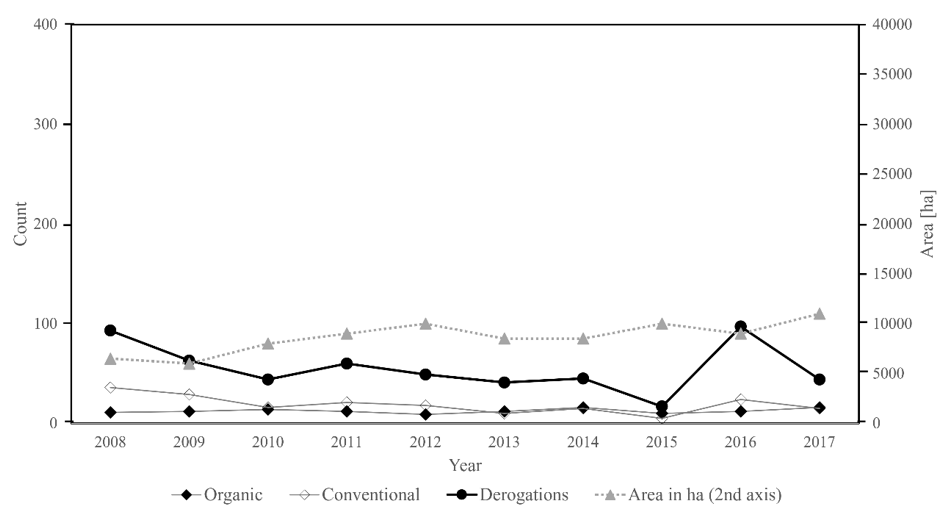
Figure A1. An overview of spring wheat
Note: The left axis displays changes in supply of cultivars from organic multiplication (Organic), changes in cultivars requested from conventional multiplication (Conventional), and the number of derogations requested per year (Derogations). The right axis displays the corresponding organic crop area (Acreage) in hectares per year in Germany.
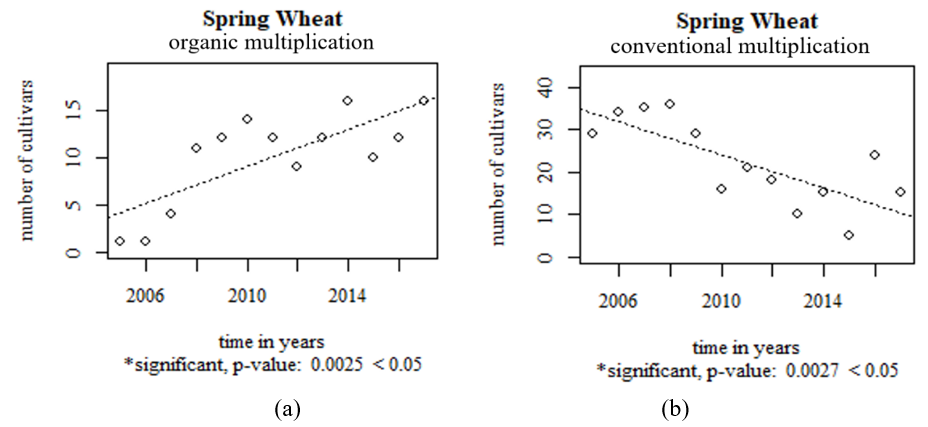
Figure A2. Scatter plots with regression lines for spring wheat during 2005-2017 (a) the number of cultivars available from organic multiplication; (b) the number of cultivars requested from conventional multiplication

Figure A3. An overview of winter barley
Note: The left axis displays changes in supply of cultivars from organic multiplication (Organic), changes in cultivars requested from conventional multiplication (Conventional), and the number of derogations requested per year (Derogations). The right axis displays the corresponding organic crop area (Acreage) in hectares per year in Germany.
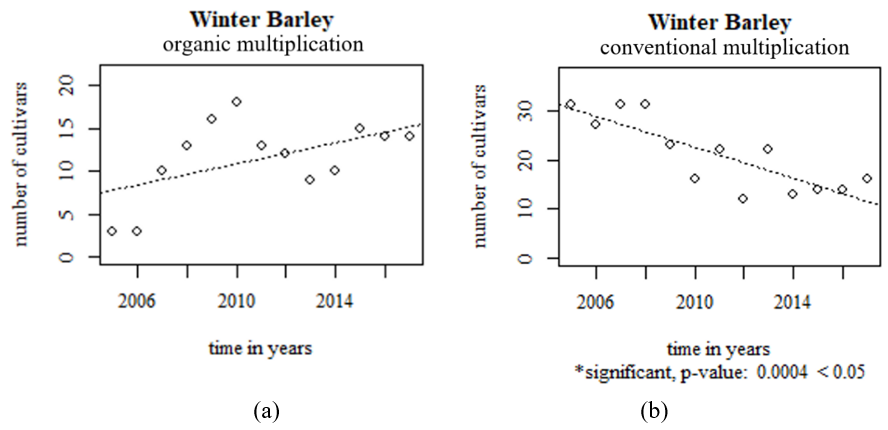
Figure A4. Scatter plots with regression lines for winter barley during 2005-2017 (a) the number of cultivars available from organic multiplication; (b) the number of cultivars requested from conventional multiplication
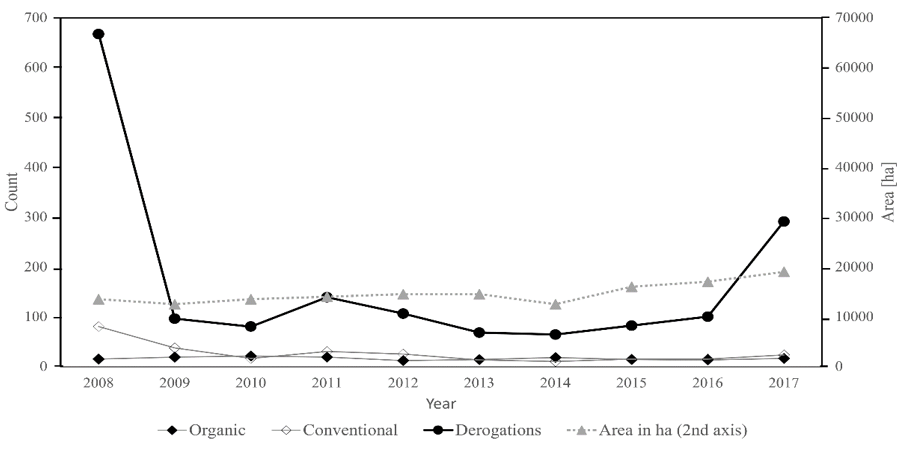
Figure A5. An overview of spring barley
Note: The left axis displays changes in supply of cultivars from organic multiplication (Organic), changes in cultivars requested from conventional multiplication (Conventional), and the number of derogations requested per year (Derogations). The right axis displays the corresponding organic crop area (Acreage) in hectares per year in Germany.

Figure A6. Scatter plots with regression lines for spring barley during 2005-2017 (a) the number of cultivars available from organic multiplication; (b) the number of cultivars requested from conventional multiplication
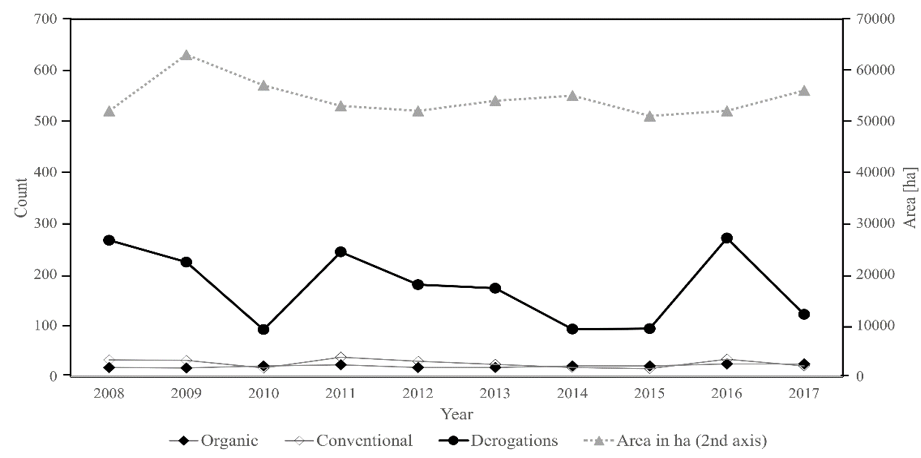
Figure A7. An overview of rye
Note: The left axis displays changes in supply of cultivars from organic multiplication (Organic), changes in cultivars requested from conventional multiplication (Conventional), and the number of derogations requested per year (Derogations). The right axis displays the corresponding organic crop area (Acreage) in hectares per year in Germany.
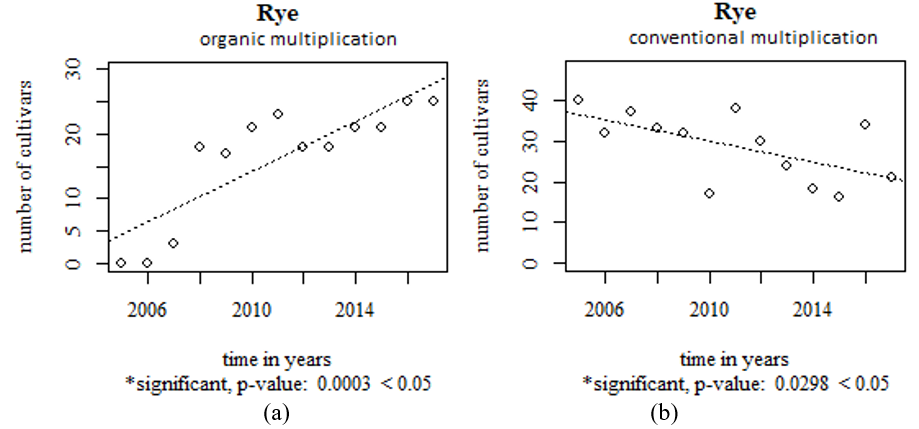
Figure A8. Scatter plots with regression lines for rye during 2005-2017 (a) the number of cultivars available from organic multiplication; (b) the number of cultivars requested from conventional multiplication
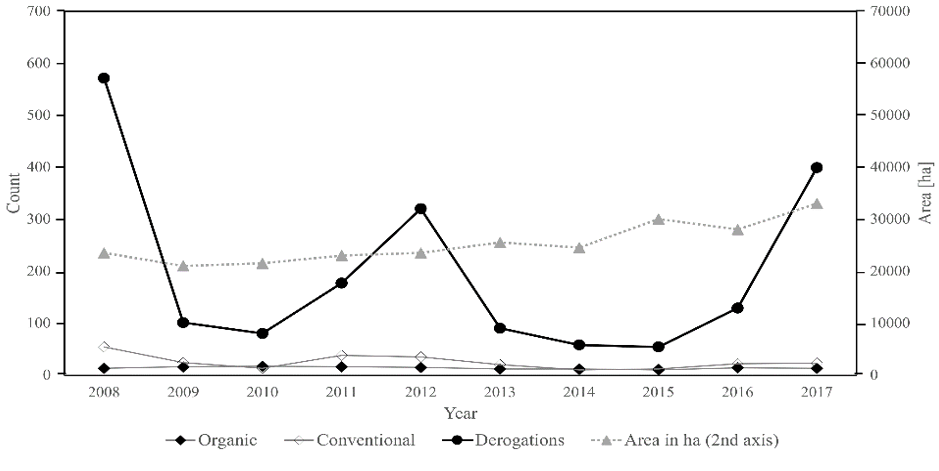
Figure A9. An overview of oat
Note: The left axis displays changes in supply of cultivars from organic multiplication (Organic), changes in cultivars requested from conventional multiplication (Conventional), and the number of derogations requested per year (Derogations). The right axis displays the corresponding organic crop area (Acreage) in hectares per year in Germany.

Figure A10. Scatter plots with regression lines for oat during 2005-2017 (a) the number of cultivars available from organic multiplication; (b) the number of cultivars requested from conventional multiplication
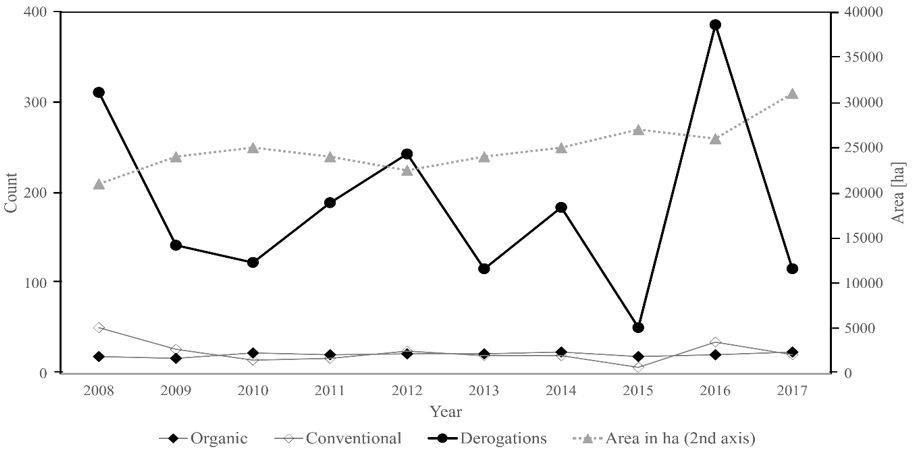
Figure A11. An overview of triticale
Note: The left axis displays changes in supply of cultivars from organic multiplication (Organic), changes in cultivars requested from conventional multiplication (Conventional), and the number of derogations requested per year (Derogations). The right axis displays the corresponding organic crop area (Acreage) in hectares per year in Germany.
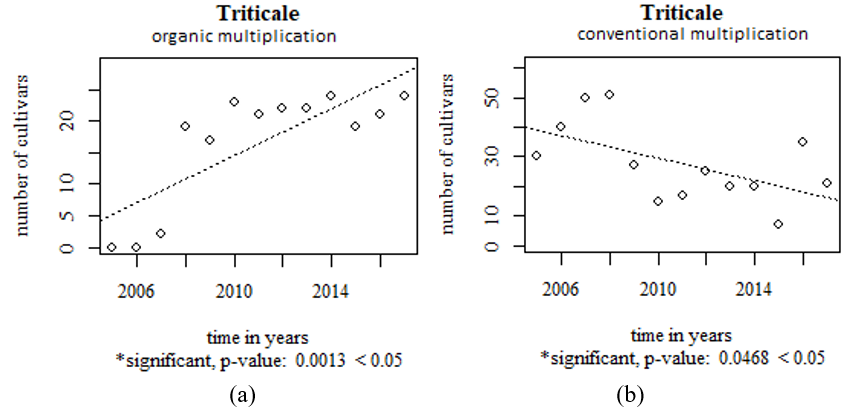
Figure A12. Scatter plots with regression lines for triticale during 2005-2017 (a) the number of cultivars available from organic multiplication; (b) the number of cultivars requested from conventional multiplication
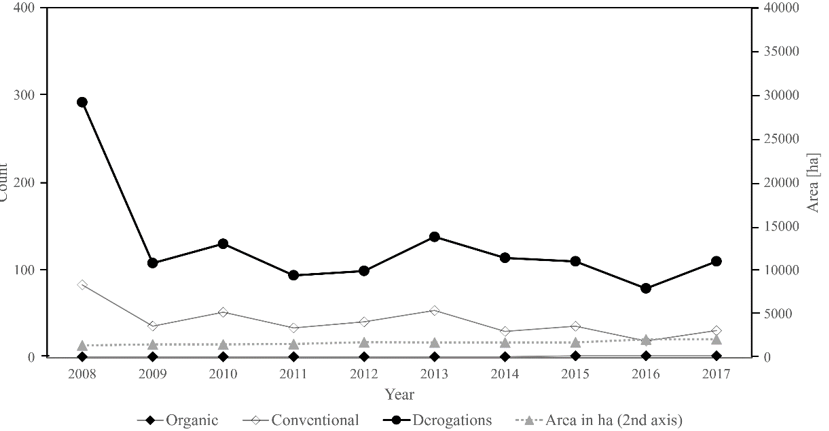
Figure A13. An overview of carrot
Note: The left axis displays changes in supply of cultivars from organic multiplication (Organic), changes in cultivars requested from conventional multiplication (Conventional), and the number of derogations requested per year (Derogations). The right axis displays the corresponding organic crop area (Acreage) in hectares per year in Germany.
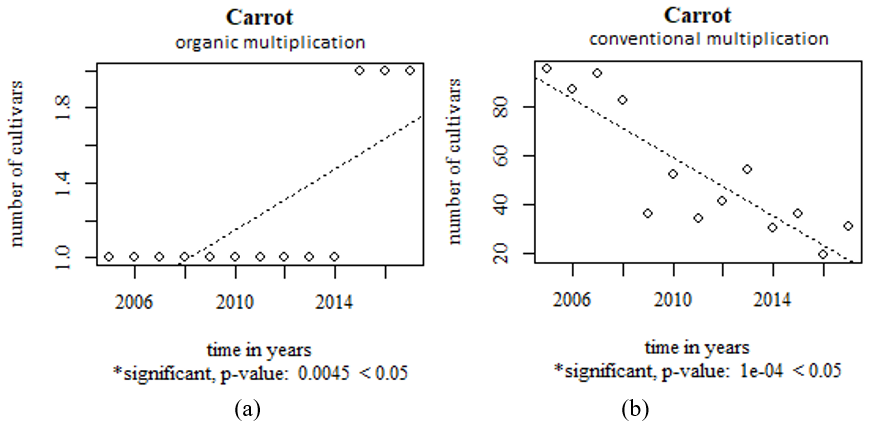
Figure A14. Scatter plots with regression lines for carrot during 2005-2017 (a) the number of cultivars available from organic multiplication; (b) the number of cultivars requested from conventional multiplication
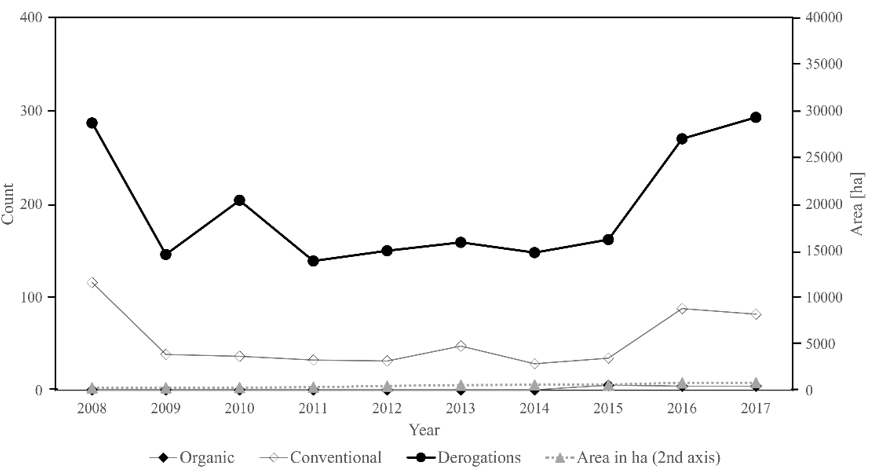
Figure A15. An overview of onion
Note: The left axis displays changes in supply of cultivars from organic multiplication (Organic), changes in cultivars requested from conventional multiplication (Conventional), and the number of derogations requested per year (Derogations). The right axis displays the corresponding organic crop area (Acreage) in hectares per year in Germany.
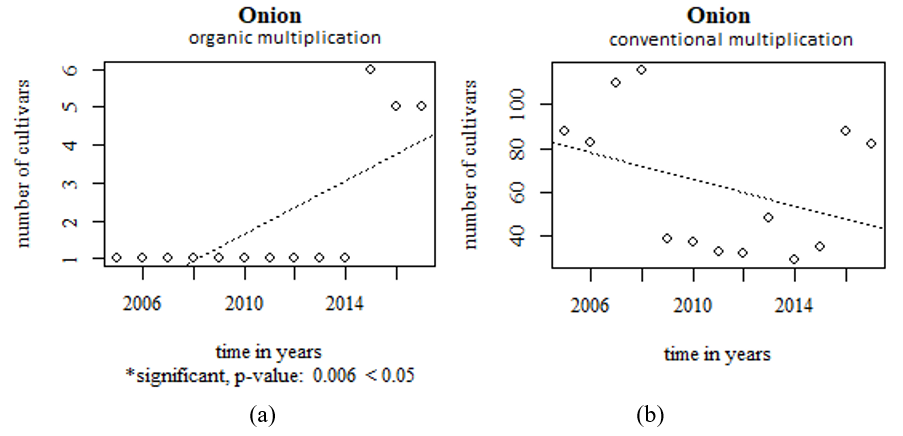
Figure A16. Scatter plots with regression lines for onion during 2005-2017 (a) the number of cultivars available from organic multiplication; (b) the number of cultivars requested from conventional multiplication
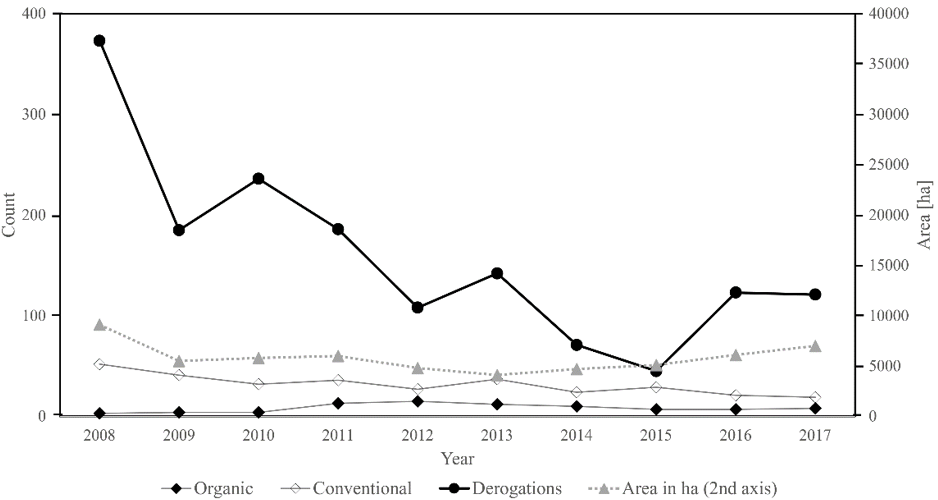
Figure A17. An overview of field pea
Note: The left axis displays changes in supply of cultivars from organic multiplication (Organic), changes in cultivars requested from conventional multiplication (Conventional), and the number of derogations requested per year (Derogations). The right axis displays the corresponding organic crop area (Acreage) in hectares per year in Germany.
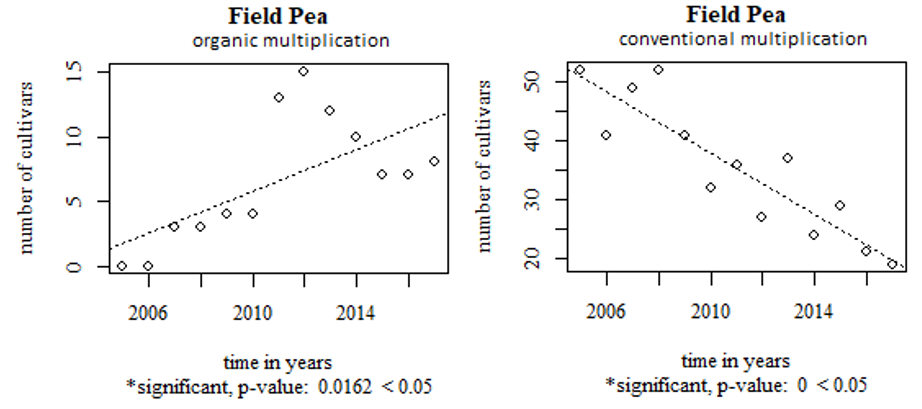
Figure A18. Scatter plots with regression lines for field pea during 2005-2017 (a) the number of cultivars available from organic multiplication; (b) the number of cultivars requested from conventional multiplication
Table A1. Summary of German organic farming acreage and number of derogations on the use of non-organic seeds of winter and spring wheat and rye
Year | Winter Wheat | Spring Wheat | Rye | |||
Organic area (ha) | Number of derogations | Organic area (ha) | Number of derogations | Organic area (ha) | Number of derogations | |
2008 | 40500 | 201 | 6500 | 93 | 52000 | 267 |
2009 | 44000 | 180 | 6000 | 63 | 63000 | 224 |
2010 | 46000 | 120 | 8000 | 44 | 57000 | 92 |
2011 | 47000 | 190 | 9000 | 60 | 53000 | 244 |
2012 | 46000 | 213 | 10000 | 49 | 52000 | 180 |
2013 | 43500 | 141 | 8500 | 41 | 54000 | 173 |
2014 | 40500 | 199 | 8500 | 45 | 55000 | 93 |
2015 | 48000 | 97 | 10000 | 17 | 51000 | 94 |
2016 | 54000 | 327 | 9000 | 97 | 52000 | 271 |
2017 | 58000 | 126 | 11000 | 44 | 56000 | 122 |
Table A2. Summary of German organic farming acreage and number of derogations on the use of non-organic seeds of winter and spring barley and spelt
Year | Winter Barley | Spring Barley | Spelt | |||
Organic area (ha) | Number of derogations | Organic area (ha) | Number of derogations | Organic area (ha) | Number of derogations | |
2008 | 8500 | 177 | 13500 | 667 | 18000 | 111 |
2009 | 11000 | 50 | 12500 | 96 | 21000 | 40 |
2010 | 9500 | 44 | 13500 | 80 | 22000 | 33 |
2011 | 8500 | 79 | 14000 | 139 | 20500 | 77 |
2012 | 8500 | 67 | 14500 | 106 | 18000 | 77 |
2013 | 9000 | 61 | 14500 | 68 | 17500 | 47 |
2014 | 8500 | 45 | 12500 | 64 | 17000 | 115 |
2015 | 11000 | 70 | 16000 | 82 | 25000 | 157 |
2016 | 13000 | 53 | 17000 | 100 | 29000 | 56 |
2017 | 18000 | 108 | 19000 | 291 | 27000 | 37 |
Table A3. Summary of German organic farming acreage and number of derogations on the use of non-organic seeds of oat, triticale and maize
Year | Oat | Triticale | Maize | |||
Organic area (ha) | Number of derogations | Organic area (ha) | Number of derogations | Organic area (ha) | Number of derogations | |
2008 | 23500 | 571 | 21000 | 311 | 4500 | 152 |
2009 | 21000 | 101 | 24000 | 142 | 5000 | 284 |
2010 | 21500 | 80 | 25000 | 123 | 4400 | 430 |
2011 | 23000 | 177 | 24000 | 189 | 4000 | 334 |
2012 | 23500 | 320 | 22500 | 243 | 4500 | 274 |
2013 | 25500 | 90 | 24000 | 116 | 8700 | 138 |
2014 | 24500 | 58 | 25000 | 184 | 9300 | 16 |
2015 | 30000 | 54 | 27000 | 51 | 11000 | 25 |
2016 | 28000 | 129 | 26000 | 386 | 12000 | 22 |
2017 | 33000 | 399 | 31000 | 116 | 13000 | 21 |
Table A4. Summary of German organic farming acreage and number of derogations on the use of non-organic seeds of field bean and pea and lupine
Year | Field Bean | Field Pea | Lupine | |||
Organic area (ha) | Number of derogations | Organic area (ha) | Number of derogations | Organic area (ha) | Number of derogations | |
2008 | 5800 | 266 | 9100 | 373 | 8600 | 163 |
2009 | 6000 | 90 | 5500 | 185 | 7800 | 66 |
2010 | 8600 | 86 | 5800 | 236 | 9500 | 56 |
2011 | 8600 | 104 | 6000 | 186 | 9000 | 123 |
2012 | 7800 | 87 | 4800 | 108 | 7000 | 144 |
2013 | 7900 | 207 | 4100 | 142 | 6500 | 109 |
2014 | 9900 | 172 | 4700 | 71 | 6900 | 115 |
2015 | 12500 | 75 | 5100 | 45 | 8900 | 135 |
2016 | 12000 | 141 | 6100 | 123 | 9500 | 189 |
2017 | 15000 | 56 | 7000 | 121 | 11000 | 163 |
Table A5. Summary of German organic farming acreage and number of derogations on the use of non-organic seeds of cabbage, carrot and onion
Year | Cabbage | Carrot | Onion | |||
Organic area (ha) | Number of derogations | Organic area (ha) | Number of derogations | Organic area (ha) | Number of derogations | |
2008 | 230 | 626 | 1400 | 292 | 330 | 287 |
2009 | 200 | 226 | 1500 | 108 | 320 | 146 |
2010 | 200 | 254 | 1500 | 130 | 350 | 204 |
2011 | 200 | 217 | 1550 | 94 | 400 | 139 |
2012 | 516 | 209 | 1757 | 99 | 512 | 150 |
2013 | 525 | 203 | 1729 | 138 | 612 | 159 |
2014 | 607 | 214 | 1734 | 114 | 640 | 148 |
2015 | 584 | 256 | 1743 | 110 | 654 | 162 |
2016 | 541 | 201 | 2079 | 79 | 856 | 270 |
2017 | 695 | 442 | 2103 | 110 | 865 | 293 |
Table A6. Summary of German organic farming acreage and number of derogations on the use of non-organic seeds of red beet and potato
Year | Red Beet | Potato | ||
Organic area (ha) | Number of derogations | Organic area (ha) | Number of derogations | |
2008 | 240 | 111 | 8150 | 1239 |
2009 | 240 | 86 | 8350 | 612 |
2010 | 210 | 77 | 8200 | 778 |
2011 | 240 | 107 | 8300 | 1014 |
2012 | 364 | 83 | 8300 | 595 |
2013 | 295 | 106 | 8400 | 810 |
2014 | 481 | 175 | 8500 | 855 |
2015 | 470 | 205 | 8600 | 474 |
2016 | 609 | 243 | 8700 | 759 |
2017 | 698 | 260 | 8900 | 963 |
